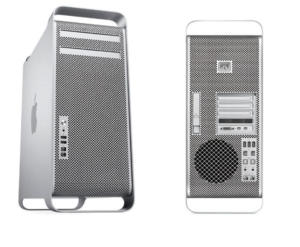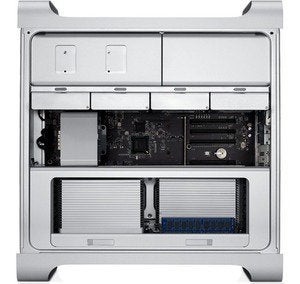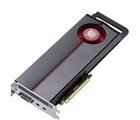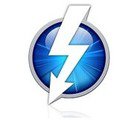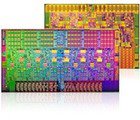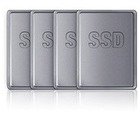There’s been quite a bit of recent speculation about potential upcoming Apple products: TVs, watches, less-expensive iPhones, Retina iPad minis, Retina MacBook Airs, new full-size iPads … almost every Apple product line is apparently being updated, and a number of new products are supposedly on the way.
But the poor Mac Pro — the one product that hasn’t seen a significant update in years —hasn’t really received its fair share of rumor mongering. It’s almost as if we’ve given up on the old fella. (Sometimes it seems as though Apple has, too: The Mac Pro still doesn’t have Thunderbolt—a feature that’s been on the Mac mini since 2011—or USB 3.0. A 2012 update to the Mac Pro offered only minor speed and memory changes.)
What’s surprising about this is that we actually have fodder for Mac Pro gossip: Back in June 2012, Tim Cook himself all but confirmed that we’ll be seeing a new Mac Pro in 2013. Yet the only Mac Pro speculation seen recently is that the next Mac Pro might be assembled in the U.S..
Even so: “Let’s talk about the new Mac Pro that we know nothing about.” Because it’s been far too long since we’ve aired pipe dreams and unreasonable expectations for what was once Apple’s flagship machine.
Except that instead of talking about an updated version of the massive Mac Pro we have today, The case made here —no pun intended— is for a smaller version.
Exercises in compromises
When it comes to non-portable computing, it is the opinion of many stalwarts that the 'tower' is the way. Prior to my current Mac even I myself, chose to make my desk a host to a string of Mac towers: a Power Mac 8100, a series of Power Mac G3 and G4 models, a Power Mac G5, and then a Mac Pro. The nature of it's expandability playing key in the decision making processes when purchasing. Want to add a lot of RAM? Easy! Need a graphics card update to keep up with the ever more demanding outputs of Creative Suite? Just whip the old one out and find a superior product from the stock cupboard. Or, running out of space on the hard drive due to Gigabytes of archived video footage; add another one, or two and a second optical drive. And if there was anything the Mac didn't have, functionality could always be added using the PCIexpansion slots.
Such expandability didn’t come without compromises, and by the time of the Power Mac G5 and Mac Pro, Apple’s tower computers were huge, hot, and power hungry: With a few Mac Pros in the office, there was no need to worry about the heating bill in the winter, just leave the Macs on over night to do the job of the storage heaters and spend what you save on the electric on a new mousemat.
But, when it came time to upgrade the desktop machine a few years back, I opted for a 27-inch Core i7 iMac, with 12Gb of RAM. To make up for the lost optical drives, I purchased a couple of external drive bays and retrofitted the superdrives from the outgoing Mac Pro.
The iMac setup has worked pretty well, but it's not hard to miss the Mac Pro’s performance and expandability. For example, while the iMac’s processor is plenty fast for every day activities, it does sometimes fall outside of olympic qualifying times when rendering large video files. And its drive performance (I/O) can be frustratingly slow, and the less said about the external drive enclosures cluttering my desk, the better. (The performance of those external drives is also noticeably slower than if they were internal.)
Wishing for more by hoping for less
But what other option was there? Apple has long had a gaping hole in its product lineup between the Mac mini and the Mac Pro. There’s also a price gap: The Mac mini enters the range at £499, while the Mac Pro jumps straight up to £2049 for an entry level model. Sure, the iMac, with prices starting at £1099, fits perfectly in that price gap, but the iMac is in many ways just a Mac mini with a built-in display—it’s not really filling that hole in terms of expandability and flexibility, and its all-in-one design isn’t an option for everyone.
The gist of the idea is that there are a good number of people for whom neither the Mac Pro nor the Mac mini is the right fit: They don’t need all the bays, slots, and other geek-wish-list features of the Mac Pro, but the Mac mini doesn’t offer enough storage or internal expandability. Similarly, some people won’t buy an all-in-one computer like the iMac because a problem with the screen means the computer is useless, and vice versa; plus, if you need a new computer, you must buy a new display, as well. (Not to mention that the latest iMacs offer essentially no internal expandability.)
What I’ve long wished for is a screenless desktop that offers power-user performance and moderate expandability.
Ideal for 2013, a wish-list for such a model would look something like this: a smaller-than-a-Mac-Pro enclosure with the latest high-end desktop CPU (or maybe even just a high-end Core i7); 8GB of RAM, upgradeable to at least 16GB; two drive bays that could accept either traditional hard drives or SSDs; and an upgradeable graphics card. It might also have a free expansion-card slot, but I’m not sure that’s as vital these days (more on that in a moment). If this fantasy Mac was priced somewhere between, £1049 and £1499, Surely that would be quite popular.
The potential market—current Mac owners looking for more power (but not £2000+ worth of it), current pro customers who would purchase multiple minitowers, and new Mac converts who currently don’t see the computer they want in Apple’s lineup—is certainly big enough to make this computer worth making.
Not just a Mac Pro, but the Mac Pro?
Of course, I’ve been hoping for this computer for many years, and I’ve been disappointed every time. However, there are a number of reasons why I think this year we really, truly—finally—may see a smaller, but still performance-focused, Mac tower.
But before I get to those reasons, here’s something else to think about. What if that Mac minitower isn’t just a new Mac Pro, but the new Mac Pro? It sounds crazy, but thanks to both technological advances and shifts in the pro market, Apple could conceivably offer a “pro” minitower and drop the full-size Mac Pro completely. I wouldn’t bet my paycheck on such a move, but for the first time, the technology is there—and Apple has a penchant for making bold, “We know better than you—trust us” moves.
Won’t high-end pro users abandon the Mac platform without a “true” Mac Pro? Some will, there’s no doubt. But many already have, arguing that it’s Apple that has been slowly abandoning the high-end market over the past half decade. (There’s some evidence for this position: token updates to the Mac Pro, dropping the Xserve and Xserve RAID, major updates to pro apps that make them seem more consumer- than pro-focused, and so on.) And other pro users may find that they no longer need a monster tower as much as they think they do. Which leads me to …
Making the case (smaller)
In the past, one of the biggest challenges that Apple would have had in designing a Mac minitower was making it powerful enough to satisfy power-user consumers and those pros who would be the most interested in such a computer—and, at the same time, keeping it reasonably priced. But technology has evolved to the point where a Mac minitower could handle all but the most-demanding pro workload. Consider:
Expansion cards A big hurdle for pro users trying to cope with non-pro Macs (and even Pro laptops) is the lack of PCI-expansion-card slots. PCI cards can be used for faster RAID performance and transcoding of video, high-end networking, complex audio/video connections, and many other things the average consumer will never need. And, of course, for high-end video cards. The lack of a PCI-card slot—or, for some people, multiple slots—has long been a deal killer for everything but the Mac Pro. And that will remain the case for some people. But many folks who in the past required PCI slots can these days make due with other solutions, thanks in no small part to …
Thunderbolt Apple’s high-speed peripheral interface hasn’t yet taken the pro market by storm, but I’d argue that one big reason for that is the shameful lack of Thunderbolt in the Mac Pro line. (Chicken? Egg?) Now that Thunderbolt has been around for a few years, and has long come standard on many Macs, high-end Thunderbolt peripherals are finally becoming widely available. For example, you can get super-fast RAID drives with Thunderbolt connections. And if you need specific PCI cards, a Thunderbolt PCI chassis will let you use many kinds of PCI cards (other than video cards) over a Thunderbolt connection. Any new Mac Pro will obviously have multiple Thunderbolt ports.
Processor speed It used to be that the small, efficient, cool-running processors used in laptops and consumer-level desktop computers just weren’t very powerful. If you wanted real performance, you needed a big tower with a huge, power-hungry processor that required a heat sink or other cooling system that was itself bigger than some laptops. But that’s not the case any more: Today’s best consumer-level processors, such as the Intel Core i7, are small, efficient, and cool enough to fit inside a MacBook Pro or Mac mini while outperforming the current Mac Pro for many tasks. (Noteworthy: Many of the “pros” I know are using Apple laptops, not desktops.) And Intel and other vendors are working on making higher-end workstation processors use less power and run cooler. In other words, a Mac minitower could be plenty fast enough for many users.
Storage For some pro users, the biggest appeal of the Mac Pro’s enclosure is that it can accommodate multiple drives. After all, many people using Mac Pros need lots of space to store huge video, audio, and image files, or other large data sets—and they want fast access to that data. But those who need the most storage and the fastest performance often end up using external solutions, such as fibre-channel storage, anyway. And the performance of Thunderbolt means you can add multiple external drives without the same performance hit you took with FireWire. (There are even Thunderbolt-fibre-channel adapters.) So it’s not hard to imagine Apple making a smaller Mac Pro and suggesting that those who need more storage instead take advantage of Thunderbolt. And thanks to Apple’s Fusion Drive technology, outfitting this theoretical Mac with an SSD and a large-capacity internal hard drive will mean better I/O performance for many tasks, right out of the box, than with the current Mac Pro.
Put all this together—Apple’s relentless efforts over the past few years to make everything smaller, cooler, and less power-hungry; the fact that you don’t need massive components to get good performance; and an apparent trend towards conceding the highest-end market—and it seems like a Mac minitower is a logical next step for the Mac Pro line.
Why not?
A common argument against a reasonably priced Mac minitower was always that it would cannibalize the iMac. I addressed those concerns in my 2006 article, but I also think the iMac’s current design is different enough from a minitower—and appealing enough to the typical consumer—that the iMac’s status as the best-selling desktop Mac would be safe. And nowadays, few would opt for a Mac minitower over an iMac solely for performance reasons: The current iMac has more than enough power for many people. (Keep in mind that Apple’s best-selling computer is rumored to be the MacBook Air, with its relatively slow processor but speedy storage.)
Today, the few people talking about this topic seem to be worried that a Mac minitower would instead cannibalize the Mac Pro. While that position might have had some merit in the mid–2000s, that’s now a harder sell than the current base-configuration Mac Pro. Yes, Apple might sell fewer Mac Pros, but is that really a huge deal? The proportion of Apple’s revenue that comes from the Mac Pro line has been steadily declining as iOS devices and MacBook sales have surged, and as the iMac has become one of the most popular desktop computers on the market. If anything, I think the number of additional Macs that would be sold would more than make up for any reduction in Mac Pro sales. (And, of course, if a minitower Mac Pro is the only Mac Pro, then the whole issue of cannibalization is moot.)
Hoping against hope?
I concede that this theoretical minitower wouldn’t satisfy all pro users—particularly the ones who need the absolute best performance and the most expandability (and, it should be said, who were once Apple’s bread and butter). Maybe Apple simply abandons these people, letting them go to specialized workstations from other vendors. Or maybe the Mac Pro lives on in a new model (or two), further relegated to an ultimate-performance niche. In any case, I’d argue that the market for my mythical minitower is big enough that it’s worth doing, and the technology is there to make it doable.
Think of it this way: Steve Jobs once said that traditional computers are becoming the equivalent of trucks, while most people will eventually need only a car. He was equating the latter with the iPad and other “post-PC” devices, but the analogy works just as well when talking about traditional computers on their own: A MacBook or iMac is a car, with the Mac Pro akin to a Ford F–350 or Dodge RAM 3500. Like many families, our family needs more space and utility than a car, but we don’t need a huge, trailer-towing, gas-guzzling truck. A midsize SUV or crossover is a near-perfect compromise—it’s plenty of “truck” for us. I’m hoping that this is the year Apple finally makes a midsize SUV.


